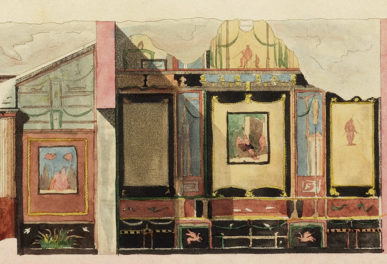January 16, 2014, marks the 40th anniversary of the opening of the Getty Villa, J. Paul Getty’s museum inspired by an ancient Roman villa.
In the 1950’s, when Mr. Getty dreamed of building a museum in Malibu to house his growing art collection, he dug deep—literally. He and his architects consulted detailed drawings by Karl Weber, the engineer who led 18th-century excavations of a Roman villa now known as the Villa dei Papyri. These became the inspiration for the Getty Villa and its gardens, as Getty believed there would be no better showcase for his ancient treasures than a villa like the ones where they were once displayed. The choice to evoke a Roman villa by the shores of the Pacific was also in keeping with his love of ancient architecture; Getty himself owned a villa outside Rome.
To mark the occasion, we went back two centuries to create a new audio tour that invites you to step back in time to experience an opulent Roman country villa of antiquity. When you visit the Villa, you can stroll its courtyards and gardens while hearing stories of everything from grand banquets to family activities to political deals. You just might hear the sound of bare footsteps on the travertine mixing with your own.
Have a listen to the introductory story in this short clip.
This audio tour guides you through marble courtyards and past languid fountains to explore ancient practices of entertainment, leisure, and commerce, all reflected in the Villa’s unique architecture. Hear, for example, how the ivy in the garden has both a mythical meaning, but also a practical one (it’s supposed help with a hangover!).
The tour was particularly entertaining to research and write because I got to consider the experience of both ancient and modern visitors, and to imagine an august ancient Roman welcoming you to his country estate. In one of my favorite tales, he treats you to a banquet featuring spices from around the world and fish from a private dock. You’re reminded to heed the symbolism of paintings decorating the reception hall around you. Each was a coded message for an educated ancient guest. The roses on the ceiling, for example? Well, even today we use the expression “sub rosa,” or “under the rose,” to encourage discretion.
In addition to presenting cultural history, the tour reveals the precise archaeological origins of mosaics, marble flooring, statuary, and wall paintings created for the Villa after ancient models. There are even a few “You’re kidding me!” moments. For example, did you know Romans kept eels as pets and bought them…jewelry? (I know, know; I didn’t believe it either.) Come stroll the grounds to hear that story and a few others besides.















How long does the Getty Villa audio tour take at reasonable tour speed if you just keep at it and don’t stop too long at each location? Thanks